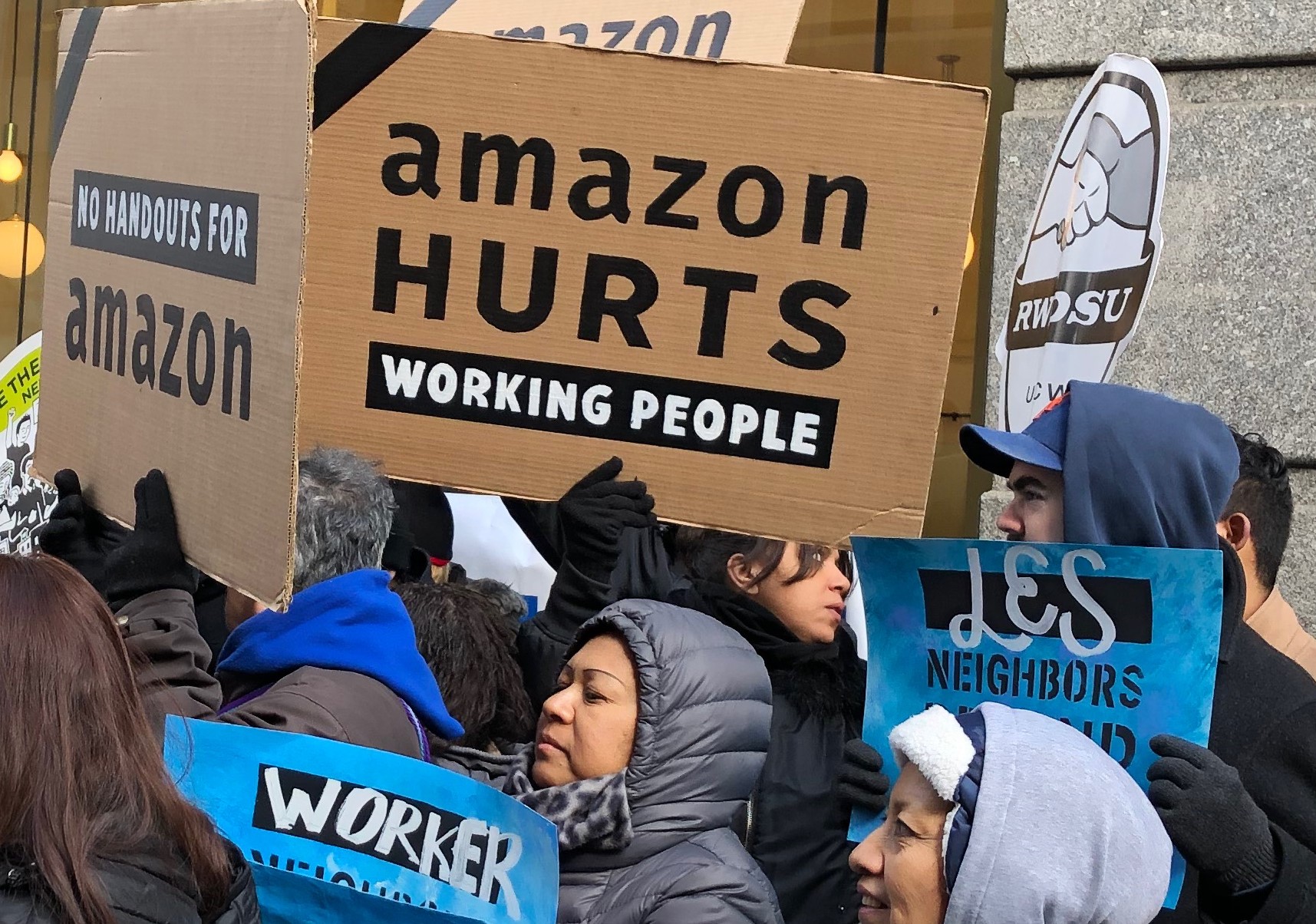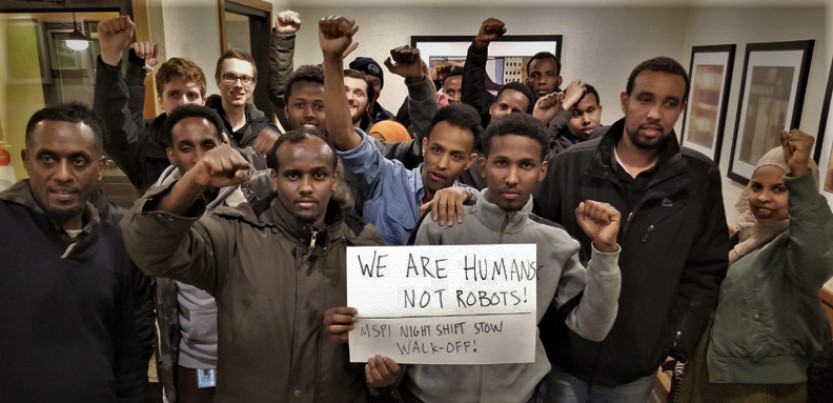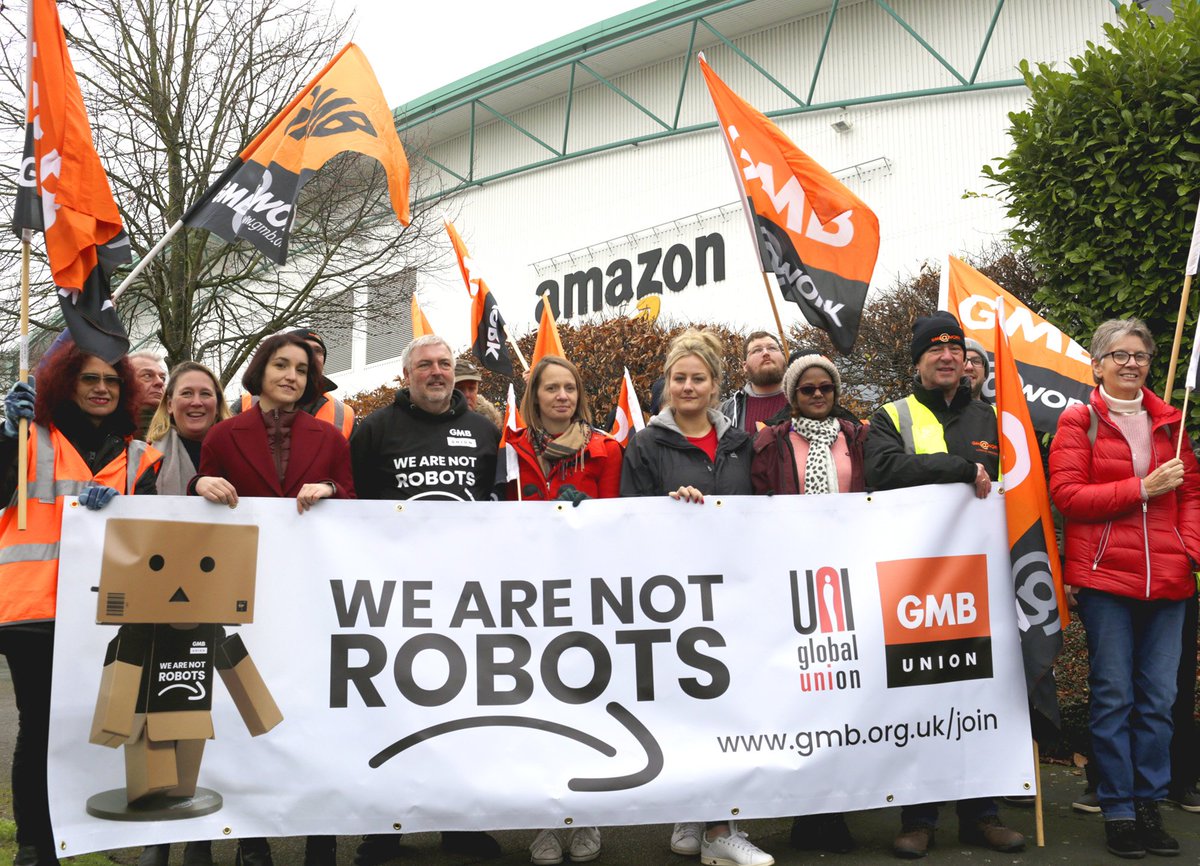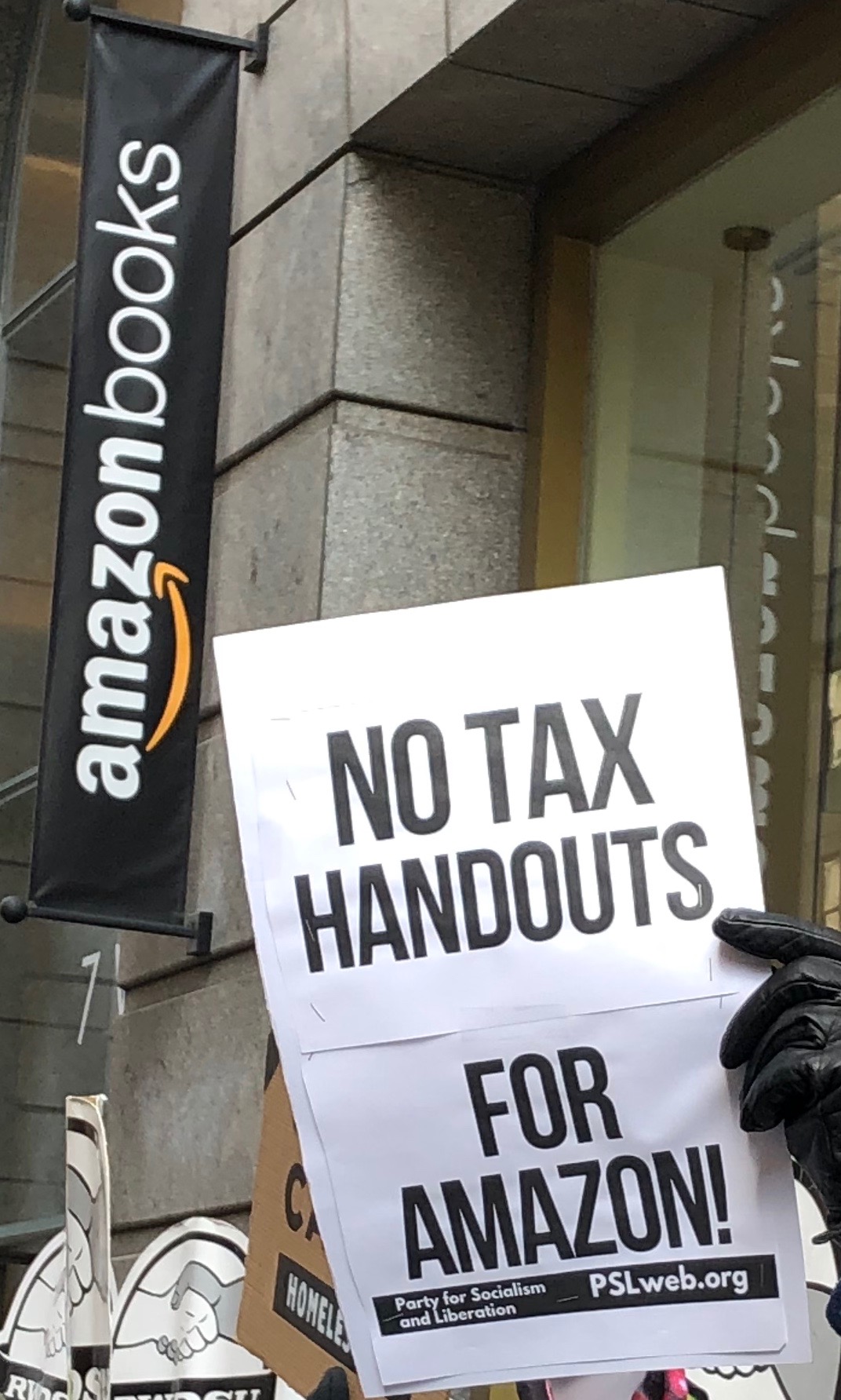
The e-commerce giant Amazon is worth a trillion dollars. Its corporate head, Jeff Bezos, is the richest man in the world. But the megacorporation is not into sharing–least of all with the Amazon workers whose labor produces all this profit.
Amazon workers are subjected to dangerous, exhausting and stressful conditions. This includes mandatory 70-hour work weeks, and working with dangerously defective machinery in overheated and under-ventilated spaces. Impossible deadlines and constant speedup has employees peeing into garbage cans and water bottles because they have no time for bathroom breaks. Wages can be so low that some full-time workers need government assistance to feed their families.
The megacorporation has the gall to claim that it meets the needs of its workers, and they “don’t need union protections.” Secretly, however, it is training management to derail or crush any union organizing that takes place.
The workers are fighting back. From Staten Island to Spain, Amazon employees are holding strikes and walk-outs to demand their right to work a normal work week, in safe conditions, with dignity, at a livable wage.
‘Robots are treated better’
The Retail, Wholesale and Department Store Union (RWDSU) last month filed charges with the National Labor Relations Board against Amazon for unfair labor practices. Amazon fired Justin Rashad Long from its Staten Island, NY, warehouse (called a “fulfillment center” by the company) on Feb. 12. Amazon is alleging safety violations, but the union calls this a “pretext for being outspoken against the working conditions at the facility.” It is illegal to fire a worker for organizing. The RWDSU is organizing workers at the Staten Island warehouse and at Amazon-owned Whole Foods.
Long sees his firing as “a clear act of retaliation” for speaking out against intolerable working conditions and attempting to organize his co-workers. Long, who worked for Amazon as an overnight “picker,” spoke at several union rallies, describing his 70-hour work week with few breaks, unhealthy conditions, and sprinkler systems and smoke detectors that are dysfunctional,. He described being forced to work 12-hour shifts in the freezing cold or such extreme heat that workers fainted.
We are “treated like animals,” with “robots treated better.” Long said, “We have asked the company to provide air conditioning, but they told us that the robots inside can’t work in the cold weather, so there’s nothing they can do about it.”
The union’s complaint comes just a month after community and labor opposition forced Amazon to abandon plans to open a corporate campus in Queens, NY. Among the things this struggle exposed was the company’s union-busting. While Amazon spokespeople have long maintained they meet their workers’ needs, and no union is needed, Amazon’s Vice-President Brian Huseman was forced to go on record in the Dec. 13 New York City Council meeting as clearly hostile to unions. No U.S. Amazon facility is unionized.
Minnesota workers walk off the job
New York is not alone. Amazon warehouse workers in Shakopee, Minnesota, have also had enough. They walked off the night shift for three hours on March 7, their second job action in three months.

The strikers work in the stow department. They find vacant space to shelve incoming goods throughout the 850,000-square-foot warehouse, and are expected to do 240-250 tasks an hour. Any downtime, such as time spent drinking water or using the bathroom, is counted against productive time.
Since 2017, the number of acceptable errors has been reduced from one in 1,000 items to one in 2,200 items, according to Abdirahman Muse, director of the Atwood Center, a worker center that has been organizing Amazon workers in Shakopee. Workers can be fired if they make errors on two occasions.
Many of the Shakopee workers are East African immigrants and practicing Muslims. If they stop to pray, Amazon counts that time against their rate.
‘Pace of work is inhumane’
Workers are expected to work faster and faster while making fewer mistakes. “The pace of work is inhumane,” said Mohamed Hassan, an organizer of the walkout. The workers are demanding that Amazon stop using temporary employees, stop counting prayer and bathroom breaks against rate, and that the company maintain the equipment, and stop threatening and firing workers for not meeting the ever-increasing rates.
Strikes in Europe
The giant company employs 575,000 people worldwide under the same dangerous conditions and at the same low wages. Amazon warehouse in Europe are so unsafe that workers are breaking bones, being knocked unconscious and being taken away in ambulances. This is why warehouse workers in Italy, Germany, Spain, and the UK staged mass walkouts on Black Friday (Nov. 23), a big sales day for the maga-corporation.

Conditions are so bad at Britain’s Amazon warehouses that ambulances have been called there more than 600 times for medical issues that included electric shocks, bleeding, trauma, and issues with pregnant women who were forced to stand for 10 hours. It is no wonder that strikers in England’s five major Amazon warehouses, chanted, “Next-day delivery should not mean a lifetime of pain for Amazon workers.”
In Germany 600 “fulfillment center” employees took to the streets in three cities. In Vercelli, Italy, the walkout left only managers to pack boxes. In Spain 90 percent of the workers left their job for two days at a warehouse near Madrid.
Amazon workers in Spain, Poland, Germany, Italy and France also staged walkouts and boycotts on Prime Day (July 16), the e-commerce giant’s global shopping event.
Bait and switch at Whole Foods
Then there’s Whole Foods. Amazon bought the food retail company for $13.7 billion in 2017. The next year, with much fanfare, Amazon announced it would raise the minimum wage for all of its U.S. workers to $15 an hour, including those at Whole Foods. Assuming a 40-hour work week, Amazon’s lowest-paid full-time employee in the U.S. would make around $30,000 a year. But this was not to be at Whole Foods. Amazon quietly cut back the regular work week there to 25 hours.
United Food and Commercial Workers International Union President Marc Perrone called this “the worst case of bait and switch I’ve ever seen. Just months ago, [Amazon] told the American people and their workers that they were raising their minimum wage to $15.00 per hour. But now it appears that this was all a public relations stunt as they are now cutting worker hours – which is a cruel pay cut, plain and simple….The men and women of Whole Foods have earned the right to a better life, and they deserve so much better than the treatment they are receiving from Amazon.” UFCW represents 1.3 million workers in grocery stores, meatpacking, food processing, and retail shops.
Company’s secret anti-union training video
Lest there be any doubts that Amazon is aggressively anti-union, a 45 minute video the company uses to train management to spot and squash union organizing was recently leaked to gizmodo.com. A narrator in the video describes it as “specifically designed to give you the tools that you need for success when it comes to labor organizing.” It takes place in an animated simulation of a fulfillment center, with the narrators dressed in the reflective vests worn there.
“We do not believe unions are in the best interest of our customers, our shareholders, or most importantly, our associates. Our business model is built upon speed, innovation, and customer obsession—things that are generally not associated with union. When we lose sight of those critical focus areas we jeopardize everyone’s job security: yours, mine, and the associates,” the video says.
Described are “warning signs” that can “indicate associate disengagement, vulnerability to organizing, or early organizing activity.” The warning signs include: Use of words like “living wage” and “steward”; Distribution of petitions and fliers; Associates raising concerns on behalf of their coworkers; Workers “who normally aren’t connected to each other suddenly hanging out together:” Workers showing an “unusual interest in policies, benefits, employee lists, or other company information;” Increased negativity in the workplace.”
Amazon then teaches managers to inspire fear in workers about organizing a union. “You would never threaten to close your building just because associates joined a union. But you might need to talk about how having a union could hurt innovation which could hurt customer obsession which could ultimately threaten the building’s continued existence.”
While warning managers that openly threatening employees crosses a line, it advises them that giving personal opinions that accomplish the same thing is legal. “Opinions can be mild, like, ‘I’d rather work with associates directly,’ or strong: ‘Unions are lying, cheating rats.’ ” The video’s narrator emphasizes, “The law protects both!”
The training video then asks managers to listen to 10 hypothetical employees and select whether their remarks constitute a “warning sign.” The “signs” include workers “loitering” in the break room after their shift, asking for a list of the site’s roster, or complaining about the absence of a living wage.
The absence of a living wage is exactly the issue. Jeff Bezos make the annual salary of a $15/hour every worker 11.5 seconds, yet he will not pay living wage to the workers who make this possible!
Taxpayers pay Amazon’s bills
There are many reasons to support the Amazon workers in their fight for safety, dignity and a living wage. An especially compelling one is that all working people are are subsidizing giant corporations like Amazon. How can this be?
We pay taxes, but Amazon does not. The second largest company in the country paid no federal taxes at all in 2018 on $11 billion in profits made that year.

Often the construction sites for future Amazon workplaces are prepared and serviced with local tax money, so Amazon doesn’t have to pay. Amazon then demands and gets state and local tax breaks where it builds warehouses. For example, community members in Queens, NY, were enraged that the state and city governments had promised Amazon $3 billion in tax breaks if it built a headquarters in their neighborhood, when that money could be used for much-needed affordable housing.
Amazon wages are so low that one-in-ten of the company’s “fulfillment center” workers in Ohio cannot feed their families, and receive public assistance through the Supplemental Nutrition Assistance Program in order to have enough food. The non profit news outlet New Food Economy surveyed five states and found that Amazon ranked among the top 20 companies with SNAP-dependent workers in four of those states. SNAP is funded by taxes.
Amazon not only super-exploits its workers, it passes its expenses onto the public as well.





